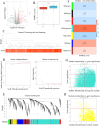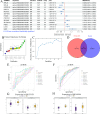Identification of macrophage polarisation and mitochondria-related biomarkers in diabetic retinopathy
- PMID: 39762849
- PMCID: PMC11706200
- DOI: 10.1186/s12967-024-06038-1
Identification of macrophage polarisation and mitochondria-related biomarkers in diabetic retinopathy
Abstract
Background: The activation of macrophages or microglia in patients' whole body or local eyes play significant roles in diabetic retinopathy (DR). Mitochondrial function regulates the inflammatory polarization of macrophages. Therefore, the common mechanism of mitochondrial related genes (MRGs) and macrophage polarisation related genes (MPRGs) in DR is explored in our study to illustrate the pathophysiology of DR.
Methods: In this study, using common transcriptome data, differentially expressed genes (DEGs) were firstly analysed for GSE221521, while module genes related to MPRGs were obtained by weighted gene co-expression network analysis (WGCNA), intersections of DEGs with MRGs were taken, intersections of DEGs with module genes of the MPRGs were taken. After that, correlation analyses were performed to obtain candidate genes. Key genes were obtained by Mendelian randomisation (MR) analysis, then biomarkers were obtained by machine learning combined with receiver operating characteristic (ROC) and expression validation between DR and control cohorts in GSE221521 and GSE160306 to obtain biomarkers. Finally, biomarkers were subjected to immune infiltration analysis, gene set enrichment analysis (GSEA), and gene-gene interaction (GGI) analysis.
Results: A number of 784 of DEGs were taken to intersect with 1136 MRGs and 782 MPRGs, respectively, after which 89 genes with correlation were taken as candidate genes. MR analysis yielded 13 key genes with clear causal links to DR. The expression trends of PTAR1 and SLC25A34 were consistent and notable between DR cohort and control cohort in GSE221521 and GSE160306. So PTAR1 and SLC25A34 were used as biomarkers. Immune infiltration analysis showed that activated NK cell and Monocyte were notably different between DR cohort and control cohorts, and PTAR1 showed the strongest positive correlations with activated NK cell. Both biomarkers were enriched in lysosome and insulin signaling pathway. The GGI network showed that biomarkers associated with prenyltransferase activity and prenylation function.
Conclusion: This study identified two biomarkers (PTAR1 and SLC25A34) which explore the pathogenesis of DR and provide reference targets for drug development.
Keywords: Diabetic retinopathy; Macrophage polarisation; Mitochondria; PTAR1; SLC25A34.
© 2025. The Author(s).
Conflict of interest statement
Declarations. Ethics approval and consent to participate: Specific ethical approval was not required for this study because all data were obtained from sources available to the public. Consent for publication: Not appliable. Competing interests: The authors declare that they have no competing interests.
Figures






Similar articles
-
Transcriptome analysis combined with Mendelian randomization screening for biomarkers causally associated with diabetic retinopathy.Front Endocrinol (Lausanne). 2024 Jul 3;15:1410066. doi: 10.3389/fendo.2024.1410066. eCollection 2024. Front Endocrinol (Lausanne). 2024. PMID: 39022342 Free PMC article.
-
Transcriptome sequencing and Mendelian randomization analysis identified biomarkers related to neutrophil extracellular traps in diabetic retinopathy.Front Immunol. 2024 Oct 17;15:1408974. doi: 10.3389/fimmu.2024.1408974. eCollection 2024. Front Immunol. 2024. PMID: 39483475 Free PMC article.
-
Deciphering Immune-related Gene Signatures in Diabetic Retinopathy: Insights from In silico Analysis and In vitro Experiment.Curr Pharm Biotechnol. 2024;25(15):2032-2045. doi: 10.2174/0113892010276304240103084841. Curr Pharm Biotechnol. 2024. PMID: 38310446
-
Integrative analysis of PANoptosis-related genes in diabetic retinopathy: machine learning identification and experimental validation.Front Immunol. 2024 Dec 4;15:1486251. doi: 10.3389/fimmu.2024.1486251. eCollection 2024. Front Immunol. 2024. PMID: 39697326 Free PMC article.
-
Transcriptome combined with Mendelian randomization to screen key genes associated with mitochondrial and programmed cell death causally associated with diabetic retinopathy.Front Endocrinol (Lausanne). 2024 Nov 20;15:1422787. doi: 10.3389/fendo.2024.1422787. eCollection 2024. Front Endocrinol (Lausanne). 2024. PMID: 39634176 Free PMC article.
Cited by
-
Immune cell contribution to vascular complications in diabetes.Front Endocrinol (Lausanne). 2025 May 21;16:1549945. doi: 10.3389/fendo.2025.1549945. eCollection 2025. Front Endocrinol (Lausanne). 2025. PMID: 40469434 Free PMC article. Review.
References
-
- Wong TY, Cheung CM, Larsen M, Sharma S, Simó R. Diabetic retinopathy. Nat Rev Dis Primers. 2016;2:16012. - PubMed
-
- Gardner TW, Antonetti DA. Novel potential mechanisms for diabetic macular edema: leveraging new investigational approaches. Curr Diab Rep. 2008;8:263–9. - PubMed
-
- Gangwani RA, Lian JX, McGhee SM, Wong D, Li KK. Diabetic retinopathy screening: global and local perspective. Hong Kong Med J. 2016;22:486–95. - PubMed
MeSH terms
Substances
Grants and funding
LinkOut - more resources
Full Text Sources
Medical

